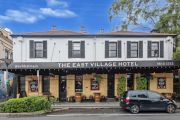
Cattle family makes $20m bid for 111,000-hectare North Star station
The well-known Bassingthwaighte cattle-breeding family has put in an offer on North Star Pastoral’s Hodgson station in the Northern Territory’s Roper region and a deal could settle as soon as this week, industry sources said.
David and Suzanne Bassingthwaighte, who with their children operate the livestock breeding company Waco Santa Gertrudis, made the offer on the 111,000-hectare station, which came on market with $20-million price expectations in an expressions-of-interest campaign that ended in June, the sources said.
The potential deal comes at a time when prices have come off their recent fast clip.
Rabobank analyst Paul Joules said he expected agricultural land as a whole, including grazing land, to undergo a “modest” 3 per cent gain this year.
”We saw the median land price increase by about 79 per cent across all agricultural sectors [between 2021 and 2023],” Joules told The Australian Financial Review.
“We think the market probably got a little bit too hot, and we’re now just seeing a bit of a correction. We now move into a new phase of probably more moderated growth in the next few years.”
The station, 230 kilometres south-east of Katherine in Arnold, has 20 divided paddocks with laneways and holding paddocks. It also has a five-bedroom homestead, a three-bedroom cottage, staff accommodation and recently renovated bathroom facilities, a large machinery shed, general purpose sheds, a workshop, airstrip and cattle yards.
Its sale will include a herd of about 6800 Brahman and Brangus female cattle. Along with 12 permanent bores which reticulate water to 25 water points, the Hodgson River and Arnold River flow through the property.
LAWD’s Olivia Thompson, Danny Thomas and Eline Wesselink are managing the campaign.
Industry veteran Colin Ross founded North Star Pastoral in 2004 when he purchased Venture Downs – a 3500-hectare aggregation that runs a Brangus breeding herd and cropping operation – in Queensland’s Central Highlands region.
North Star became one of the country’s biggest landowners, but Ross has since sold a number of stations, including Limbunya and Maryfield stations in 2022, which span a combined 670,000 hectares.
The two stations’ pastoral leases were purchased for $103.4 million by troubled investment company WealthCheck before it was placed into liquidation last year. AAM Investment Group leased the two stations and purchased a herd of about 50,000 cattle.
Beef and livestock prices were strong now, boosting sentiment that could trickle into land values over the next few years, Joules said.
“That US market has been a big supporting factor, and the fact that there’s a 50 per cent tariff on Brazil at the moment, it means that Australia is in quite a good position to potentially even increase exports into the US,” he said.
One of the Bassingthwaighte family’s other properties is the 265,000-hectare Epenarra Station in the Top End’s Barkly Tablelands, which they purchased for about $14 million in 2019.
Separately, one of the world’s biggest sheep stations Madura Plains has come to the market – for only the second time in its history.
Jamestown, SA-based family company CC Cooper & Co is offloading the aggregation of the two pastoral leases, Madura and Moonera, which have a combined area of 711,638 hectares, along with more than 60,000 sheep. The sale will include all livestock, plant and equipment.
Tom Russo, chief executive at Elders Real Estate, said CC Cooper & Co had redeveloped the station during their nine-year ownership, and properties like it rarely came onto the market.
“History would show that these large pastoral stations have typically been held for multiple generations,” Russo said. “It’s such a unique asset in terms of its location and its scale. It’s very difficult to provide comparable transactions.
“We’ll be looking for the market to provide us with an idea with what they think it’s worth.”











